Black Pudding: Cooking with Blood and Other Culinary Oddities (Warning: Not for the Squeamish)
by Ken Gargett
If you like your steak well done, charred to a crisp, look away. If, on the other hand, the rarer your steak the better, then read on.
Black pudding
If you do not know what black pudding is, you may be thinking a decadent dessert, perhaps a very dark chocolate cake type of thing? If you do know what it is then you are either suddenly thinking of how delicious it is and how long before you can next enjoy one or you are running for the hills, thinking how utterly disgusting and how on earth could anyone even look at one, let alone eat it.
I am very much in the former camp. I absolutely love black pudding.
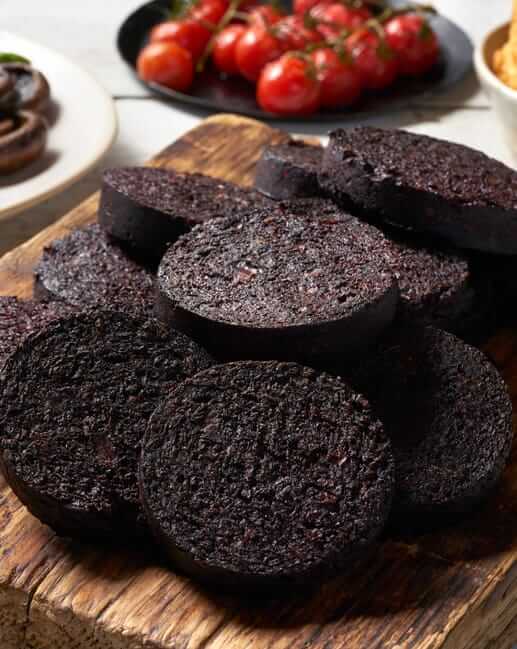
Stornoway black pudding roll (photo courtesy www.campbellsmeat.com)
Black pudding forms just a small part of the array of offal. Some avoid offal like the plague; others adore it, finding it “offally good” (I thought I should get that out of the way early).
This is a huge topic so I am only touching on it briefly, just scratching the surface. However, if COVID-19 ever allows us to travel again, next time I get to Singapore I’ll report on the most brilliant fish head curry (I know just the place!).
If I may continue to digress, I have always had a bit of a fascination for the weird and wonderful. Quite some time ago, a chef and I were doing Australian food and wine presentations in Vietnam at some of the wonderful hotels there. We had a lunch free, and I was determined to get to a little place I’d read about – this was before the internet made everything common knowledge.
In the backstreets of Ho Chi Minh City, this little restaurant allegedly served all manner of unlikely dishes. I was very keen to try snake.
I was first patron of the day; as it turned out, only one other person turned up for lunch. The place was more like a small zoo than a restaurant, which was a bit depressing, with cages of snakes, bears, land tortoises, and so much more.
————————————————————————————————-
————————————————————————————————-
I ordered a dish of snake – and, yes, it does taste like chicken – but as the dishes were all small, the lady in charge suggested I should order something more. I thought bat looked interesting. This was years before the poor things got linked to every disease on the planet. I looked through the list of “bat options” and chose “bat with green beans.”
“No,” my host said most emphatically. I asked why. “Not for you,” I was told.
So I immediately assumed this was some sort of “the hopeless foreigner won’t be able to handle our food” thing.
I said I would like to try it. “No!” came the response. We went back and forth.
Finally, I asked if they were out of bat – given the cages, they were not out of much. “No,” she assured me. “We have bat.”
“Then why can’t I try it?” I asked.
She looked at me, and I am not making this up, and said that the bat would be no problem. “But you won’t like the green beans.” I had sautéed bat. Not worth it. You’d need to eat 50 of them for a half-decent dish. And I still have no idea what was with the green beans.
I was still the only person there at this stage, and one of the waiters was bored. So he hooked a cobra from one of the cages and tossed it on the floor to annoy it. I climbed a sheer wall in no time while this idiot kept flicking its nose. I assumed it must have been defanged, but from the way the waiter followed me up the wall when the cobra got really angry I suspect not. When it calmed down, he caught it and returned it to the cage with the rest of them.
Finally, another diner came, a gent from Taiwan. Lovely bloke. We chatted away. He insisted I try what he had ordered. I was very hesitant as I had no clue what it was, but eventually took a spoonful. It was greasy and fatty and absolutely awful, but clearly my friend loved it. I asked what it was. Bear paw. Never been so utterly horrified by anything in my life. I would not have eaten bear paw at the point of a gun in normal circumstances. Not a place to which I will ever return.
So, to declare my hand, I do love offal, but there are limits. And the endangered stuff, no thanks.
Offal is technically the organs of a butchered animal, and cultures all over the world have made specialties of it. Others have forbidden it – best that we don’t go down that road here.
————————————————————————————————-
————————————————————————————————-
Offal
Haggis is perhaps the most famous, the Scottish national dish, a “pudding” made from the heart, liver, and lungs of a sheep. Sweetbreads are another famous one – basically, the throat and pancreas of calves or lambs. But like most of these things, definitions blur: sheep, cattle, pigs, and goats are all involved.
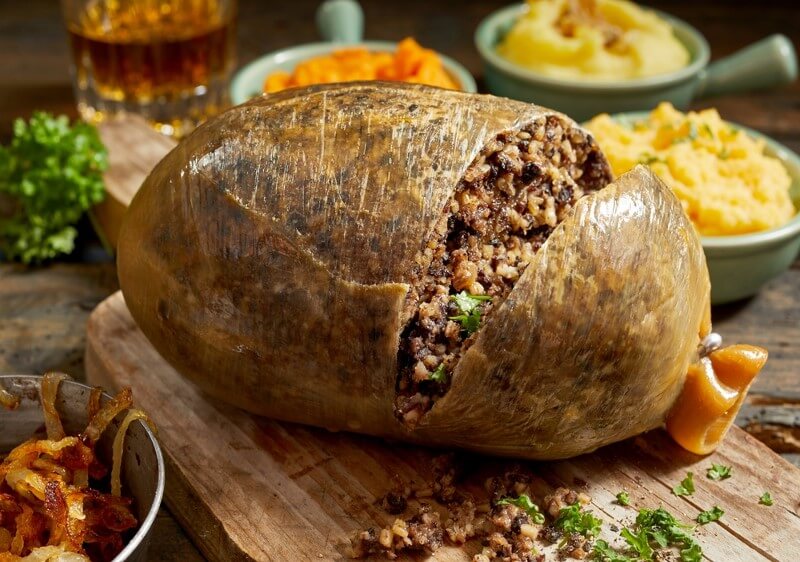
Haggis (photo courtesy www.gastronomiac.com)
Chitterlings or chitlins (honestly, I always thought that chitlins was something made up for movies until I started to research this, but they have been known as that since around 1400 and even mentioned by Thomas Hardy in Tess of the D’Urbervilles, which I read at school – or more correctly, was made to read at school. But I don’t recall the chitterlings).
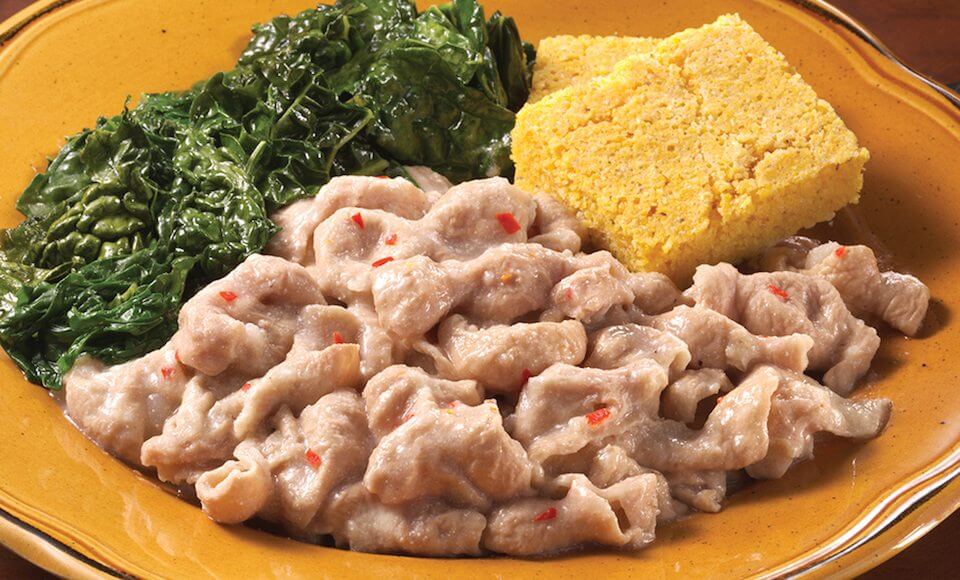
Chitlins (photo courtesy www.thetravel.com)
Apparently, chitterlings are made from the large intestines of a hog. There are varying versions from Turkey, Spain, Greece, the Balkans, and so on. In France, andouillette is a sausage made from pig chitterlings while saucisson is one using pig chitterlings as both ingredients and packaging. There are versions all through Latin America and the Caribbean. There is, it seems, almost no part of a sheep, cow, goat, and pig that someone, somewhere, has not found a use for in local cuisine.
I hail from a family where very few of us are in the slightest way adventurous when it comes to food (but we are headed toward Christmas so best not to annoy them too much with stories – I was nearly excommunicated from the family when I ordered chicken’s feet for my mother in a restaurant in Hong Kong) and am usually considered the black sheep of the family from a culinary perspective.
My father, our other black sheep, enjoyed his offal – lambs’ brains, liver, but especially tripe. My mother refused to cook it for him other than in that old, traditional method of cooking in milk. The kitchen would stink for days, and it seemed horrible. But tripe well done, and there are so many options, is something gloriously special. Goat tripe from Jamaica, tripe in tacos in Mexico, curried tripe.
COVID-19 permitting, a small group of us meet once a year at Tartufo in Brisbane for what we call the tripe lunch. We have had fans fly from as far as Japan to join us. It started as chef/owner Tony Percucco was overheard claiming he made the best tripe in Australia. We set him the challenge of a “head-to-toe” lunch, and he has never let us down. Entry is one seriously good bottle of wine.
————————————————————————————————-
————————————————————————————————-
In China, offal is practically compulsory. That requires a book, not an article. Japan, Korea, the Philippines likewise. In Australia and Britain, steak and kidney pie has long been very popular. In New Zealand, terotero is a dish made from cleaned intestines – sheep, lamb, and sometimes pigs – braided and boiled with potato and cabbage. Needless to say, cleaning intestines is critical in every culture where they are used.
Sausages are an obvious item – intestines were usually used for their casing and still are for many. Indeed, there is a belief that black puddings/blood sausages were the very first form of sausage ever made.
Culinary curiosities
Offal items can be far more than curiosities. Foie gras and paté, for example, are considered great delicacies. But offal is also used widely for pet food and in days gone by was thrown at criminals in stocks.
I recall being in Barcelona many years ago where friends took me to the bullfights, now banned in that city. It seemed everything that could happen did. At one stage, it was bulls 2, bullfighters 1. Apparently, it is extremely poor form to cheer for the bull.
A great spectacle but perhaps a “for-or-against” debate for this particular sport is for elsewhere. A local mentioned to me that the testicles of the unfortunate bulls would be sold on opening bell at a particular store in their amazing markets, La Boqueria on Las Ramblas (a must visit). I was there early the next morning but unfortunately not early enough and they had already been sold. Quite what I would have done with them, I’m not sure. Possibly taken them to a restaurant and asked them to cook them? One of those things that seemed a good idea at the time.
I was a little more successful when I tried to make a sheep’s head stew. I was introduced to this gem by two brothers from Iceland with whom I spent time traveling Africa. One day, they decided to cook their specialty. Two sheep heads were purchased, cleaned, cooked, and buried in a pit with hot rocks, much like a New Zealand hangi. Fabulous.
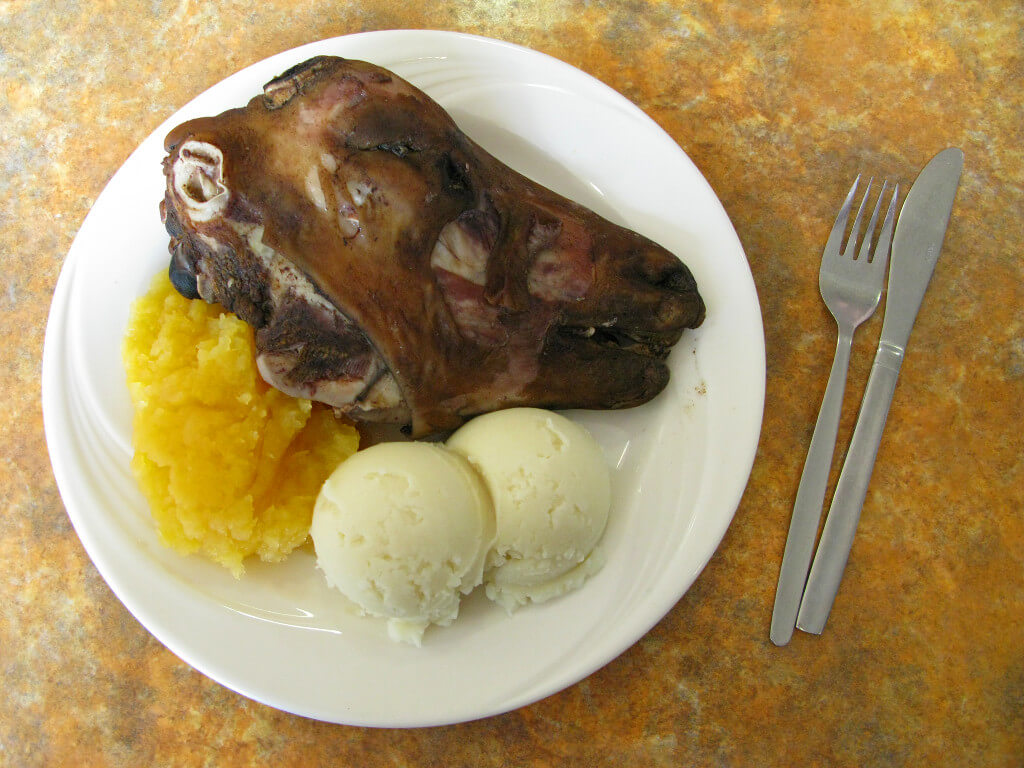
Icelandic sheephead dish (photo courtesy Schneelocke/Wikipedia)
I tried a version cooked in a pot rather than the ground. My friends all loved it till one discovered the skull in the kitchen. They all then decided it was the worst thing they’d ever eaten, including those who’d already scoffed seconds!
The saying “to eat humble pie” originally comes from pies made with animal offal: tongue, tripe, sheep’s head, lamb’s feet, pigs’ trotters, liver, hearts, spleen, udder, bone marrow, veal lungs, brains, sweetbreads, head cheese, testicles, pigs’ bowels, kidneys, pigs’ ears, chicken feet, gizzards, tail, pork snout, hooves, and more. All used and enjoyed somewhere in the world.
————————————————————————————————-
————————————————————————————————-
Sisig from the Pampanga province in the Philippines is made from the skin on a pig’s head, but they also use the ears and brains (and chicken liver) when making it. Tai pla, popular in southern Thailand, is a salty sauce made from the innards of the short-bodied mackerel.
There are so many options here that I could go on listing them for many more pages. So far, I’ve hardly scratched the surface. Dishes that may seem weird and wonderful to us (or utterly disgusting depending on your point of view) are part of the culture for others. One man’s bowl of cereal is another’s blood stew!
One of the reasons that I have always been happy to try these dishes (okay, not bear paw stew) is simply that locals eat and enjoy them. Just because they are not familiar does not mean they should be avoided. Though I’m sure I’ll meet some that are a bridge too far. Lebanon’s fish eyes – raw, boiled, or fried – might be that bridge.
Care really is needed: liver lovers, avoid the liver of dogs, seals, and polar bears. All are toxic to humans.
Fugu, the famous pufferfish that has literally been the death of diners when not prepared correctly – adventurous diners want sashimi experts, who allegedly train for seven years to perfect this skill, to prepare the flesh/liver so that there is the merest hint of the toxins to give the thrill but not to the extent that it is fatal.
The idea of trying something that could be fatal, where the chef might have had a fight with the wife that morning and not be concentrating, really doesn’t thrill me at all.
Some years ago, fly fishing in the Christmas Islands (the Pacific version, not those in the Indian Ocean), I caught a fugu. Bit embarrassing as I was after bonefish at the time. My guide grabbed it to take home as apparently it was a popular dish to be served to the children in the village.
I asked if he wasn’t concerned about poisoning them. He looked at me as though it was the dumbest question he’d ever heard and simply said that no, he wasn’t. They simply cut the poisonous bit out. Makes sense.
————————————————————————————————-
————————————————————————————————-
Back to black pudding
Today, however, we are focused on the delicious black pudding, one of the many forms of blood sausage. If you are reading this from the USA, you may wonder what I am talking about as I understand such things are banned in parts thereof (perhaps the situation is not so dire, and it is only that you are banned from importing them).
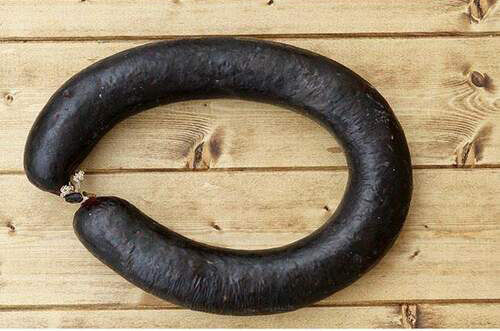
Black Pudding (photo courtesy www.ackroydsbakery.com)
Consuming blood and items of food made from blood sounds like a Dracula horror story, and in some places it is considered taboo. But in many places, it is commonplace. Some cultures use it as a thickener for sauces. It has been used during times of famine. Some use it to thicken the juices when making coq au vin.
There are endless examples of blood soup and stews in Ecuador, Korea, Germany, Finland, Vietnam, China, ancient Greece, Mexico, and many more. The blood can come from pigs, geese, ducks, chickens, goat, ox, and more. But we are talking sausage, not soup.
Again, so many options from around the world – not just black pudding but biroldi, Blutwurst, morcilla, moronga, mustamakkara, verivorst, drisheen, various types of boudin, and so on.
Basically, the blood of the chosen animal is cooked until thick enough to congeal when cooled and then mixed with filler such as barley, oatmeal, rice, bread, meat, fat, and so on. Scandinavia seems to prefer blood pancakes, each to their own.
Making hardened blood products is also not uncommon – China makes a blood tofu with the blood from a pig or duck (it is normally cut into squares rather than made as a sausage). In Hungary, pig’s blood is mixed with onions and fried for breakfast.
In Korea, blood curd is used in what they call “hangover soup.” In the Philippines, a common street food is called “betamax.” It is simply cubes of pork blood grilled on skewers, known as betamax because they resemble those old Betamax tapes. And, of course, in China and Vietnam snake blood is considered by some to be an aphrodisiac.
Definitely worth noting that blood is considered healthy food. For example, pig’s blood is rich in vitamin B2, vitamin C, protein, iron, phosphorus, calcium, niacin, and other nutrients. The Inuit have long drunk seal blood for its health benefits.
I’m sure most of us have seen movies or documentaries where the Masai in Kenya drink blood, literally fresh from their cattle. It is not so simple for black pudding. Obviously high levels of salt and saturated fats suggest that one needs to be wary and perhaps limit consumption to special occasions, but the positive is that black pudding is low in carbohydrates and high in both zinc and iron as well as protein.
One health website named black pudding a superfood (oh, if only), which seems rather optimistic given the high fat content. Apparently, there are even vegetarian and vegan versions of black pudding, which seems rather bizarre.
Something I have not touched on is the religious implications, “the blood and body of Jesus Christ.” Jewish, Greek Orthodox, and Muslim cultures forbid the consumption of blood. In the seventeenth century, there was even a theological debate about the consumption of black pudding. Many Christians, especially Methodists, believed that consumption should be banned.
Sir Isaac Newton was steadfast and vocal in his distaste for black pudding. Opponents of the delicacy used this as “non-religious support of their beliefs,” though Newton opposed consumption simply because he believed it turned men into animals.
In 1652, Thomas Barlow, a future bishop of Lincoln, asserted in a work called “Trial of a Black Pudding” that black pudding was a violation of both Jewish law and the Christian exemptions as dispensed by the Apostles.
Perhaps that is a topic for another day.
In Mongolia, when Genghis Khan laid down his Code of Law, the Yasa, he mandated a particular method of killing sheep so that the blood be saved for making sausages. That method is still used today.
When I started researching this piece, I expected to find a number of dishes I’d never encountered, but I had no idea of the incredible extent of “blood cooking” around the world.
————————————————————————————————-
————————————————————————————————-
Desserts from blood?
It sounds crazy but in Portugal, papas de moado is made from pig’s blood, flour, sugar, nuts, and spices. The Welsh use goose blood to make a Christmas pastry. In Italy, sanguinaccio dolce is made from pig’s blood, sweetened with chocolate, pine nuts, raisins, sugar, and milk.
Apparently, this dish is very popular at Carnevale, and I’m sure no one will be shocked to learn that it was a favorite of Hannibal Lector (at least in the TV series). But I digress.
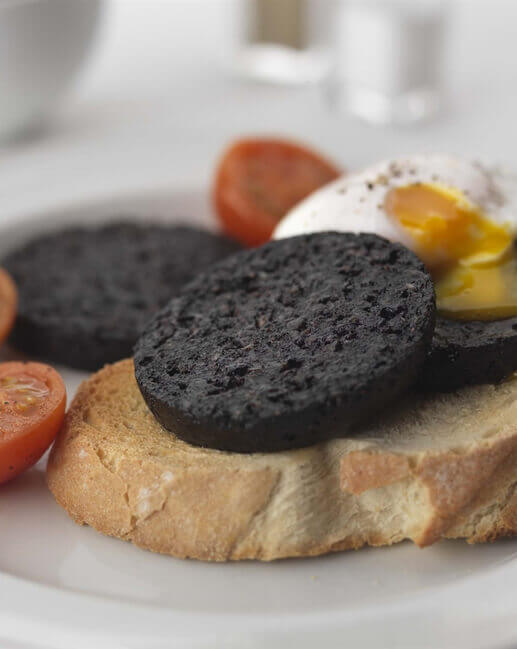
Black pudding on toast (photo courtesy www.campbellsmeat.com)
Black pudding is simply the British version of blood sausage. The casing is filled with blood and filling and then cooked or dried, solidifying when cool. The blood can come from a range of animals, though pig seems to be the more popular option. Chicken, geese, ducks, cows, yaks, donkeys, sheep, goats, and horse are all used somewhere around the world.
The filler varies widely. Bread, barley, oatmeal, cornmeal, meat, fat, suet, onions, cereals, chestnuts, and buckwheat tend to be favored throughout Europe and the Americas. In Latin America, Asia, and the Iberian Peninsula rice plays a large role. Spices vary from region to region.
Barbados has a version that includes sweet potato. Puerto Rico includes peppers, cilantro, and garlic. A Cajun version includes green onions, pork, pork liver, and rice. Chile has a blood sausage that includes chopped onion and spices, cabbage, peppers, watercress, rice, meat, and occasionally dried fruit or nuts.
In Nepal, yangben is included, a type of edible wild lichen. In Transylvania (be fair, you knew it had to come), the filler is usually preboiled rice seasoned with pepper, garlic, and basil. Sweden often sees the inclusion of beer, treacle, and onion in that version. Portugal uses parsley. One version of Spain’s morcilla uses mashed potatoes as filler.
Be aware that if you are in Korea and order a “sundae,” you won’t get ice cream: you’ll get a blood pudding. There are sweeter versions that include honey, citrus peel, chocolate, raisins, and/or sugar.
There are hundreds of versions around the world and just as many variations on the theme of preparation. There are even plenty of recipes on the internet if anyone wants to try making their own, but unless you really know what you are doing I suggest buying them readymade. Blood is highly perishable and quickly attracts bacteria.
————————————————————————————————-
————————————————————————————————-
A little black pudding history
Blood pudding has been around for centuries. In 428 BC, Plato claimed that this style of sausage was invented by the Greek Aftónitas.
It was a favorite of Homer (of Odyssey fame, though it is hard to imagine that Homer Simpson wouldn’t scoff it as fast as he could). Around 800 BCE, when Homer wrote The Odyssey he mentioned blood sausages. In Book 18 of the classic, Homer (not Simpson) wrote, “Here at the fire are goats’ paunches lying, which we set there for supper, when we had filled them with fat and blood.”
He also wrote in Book 20, “As when a man beside a great fire has filled a sausage with fat and blood and turns it this way and that and is very eager to get it quickly roasted.” Subsequently, he has Odysseus fight “for the prize of a stomach stuffed with pig blood and fat.”
It was also well known as a favorite dish for King Henry VIII.
Black pudding originally hails from Britain, whether that be England, Scotland, or Ireland (Wales doesn’t seem to get much of a mention in its history) and has been around since at least the first century BCE. There is mention of blak podyngs in 1450. Rather disturbingly, there is a fifteenth-century English recipe that used the blood of a porpoise – a dish restricted to nobility.

Stornoway black pudding roll (photo courtesy www.campbellsmeat.com)
Black pudding is usually made from pigs’ blood (historically, it was usually cow or sheep but that has changed over the last century) and a filler such as oats or barley (and pork fat). It is usually spiced with marjoram, thyme, mint, or whatever takes the makers’ fancy.
It is the use of a larger amount of cereal that makes the black pudding different from other blood sausages from around the world, though they are all riffs on the same theme. The ingredients would be placed into natural casings of intestine, which were then boiled. These days, the casings are much more likely to be synthetic cellulose skins.
There is no single recipe. Black pudding varies considerably from region to region. Some use breadcrumbs or flour, percentages and types of fat vary, pennyroyal is a spice used by some, especially in north Yorkshire. Others use cumin or parsley. It seems that a good black pudding is more valued in Scotland and the north of England than in places such as London.
Immigrants to provinces in eastern Canada brought black pudding with them as did those to Australia and New Zealand.
Black pudding from Stornoway was granted Protected Geographical Indication of Origin in 2013. The Sneem Black Pudding from County Kerry, usually made with cow’s blood, has PGI status as well.
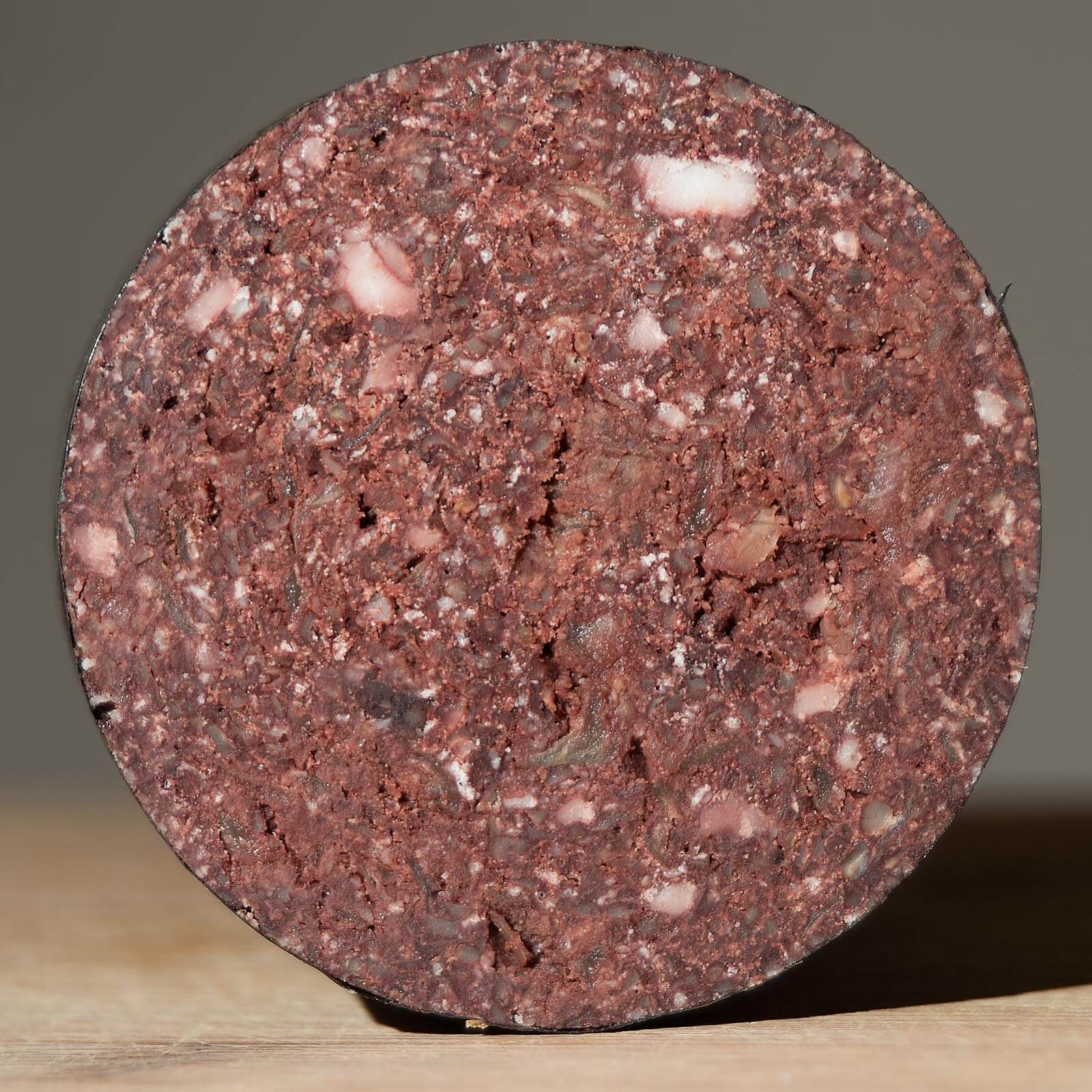
Slice of Stornoway black pudding (photo courtesy Alexbrn/Wikipedia)
For many, Stornoway’s is the king of black puddings. Made on the Isle of Lewis in the Western Isles of Scotland, in addition to the blood, which can be that of pig, sheep or cow, the ingredients are usually beef suet, oatmeal, and onion.
There is a small problem with marketing black pudding from Stornoway: apparently, a great many of the families on the island have the surname of MacLeod, meaning that you are never quite sure which you are purchasing.
————————————————————————————————-
————————————————————————————————-
The French version of black pudding is called boudin, and it is believed that this word was translated into English as “pudding,” which would mean that the original puddings were very similar to today’s black pudding rather than what we might think of as a traditional pudding for dessert.
I believe a gentle frying or grilling is the ideal way to prepare black pudding, but it can also be boiled or baked and is even deep fried in parts of Britain. It usually forms part of breakfast; indeed some believe an English – or, more likely, Scottish – breakfast is not complete if it does not include black pudding (I prefer it as part of dinner – undoubtedly heresy to some). Some will slice a cooked black pudding and consume the slices cold or as part of a salad.
White pudding is very similar to its black sibling, though has one very important difference: it is not made with blood.
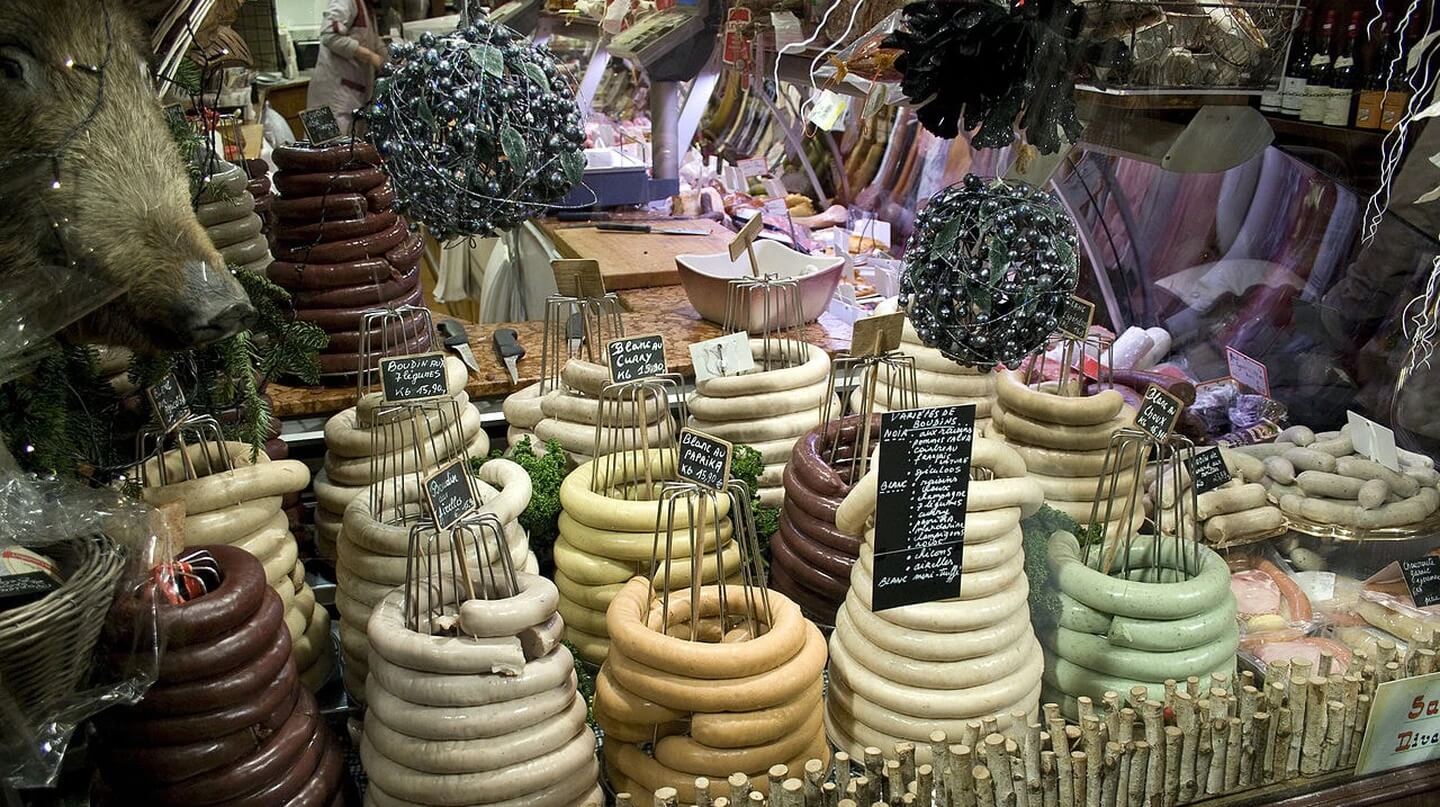
Black pudding festival (photo courtesy www.theculturetrip.com)
Naturally, there is a World Black Pudding Throwing Championship held in the town of Ramsbottom, though it seems largely to be a battle (far less bloody than some from the past) between Lancashire and Yorkshire. It has been held since the 1980s.
A 20-foot-high pile of Yorkshire puddings is constructed outside a local pub (shocker!), and the competitors hurl black puddings at it to see who can knock the most down. Of course, there are black pudding societies and festivals.
In Mortagne-au-Perche in southern Normandy, the Confrérie des Chevaliers du Goûte Boudin (“Brotherhood of the Knights of the Blood Sausage”) exists to “defend the reputation and quality of blood sausages.”
On the third weekend in March, they organize the world’s largest blood sausage competition, usually with around 400 to 600 participants, not just from France, but from across Europe. The jury of four, which contains only a single butcher, awards the Grand Prix International du Goûte Boudin to the best of them.
Now, if you’ll excuse me, I need to finish preparing dinner. No prizes for guessing what is on the menu!
* This article was first published 05 October 2021 at Black Pudding: Cooking With Blood And Other Culinary Oddities (Warning: Not For The Squeamish)
You may also enjoy:
Serra De Estrela Cheese: Rich, Ripe, And Full Of Intense, Tangy Flavors
Leave a Reply
Want to join the discussion?Feel free to contribute!






Thank you for a near-encyclopaedic article on black pudding and other delights, Ken. I share your enthusiasm. One of the more (relatively) sophisticated ways of enjoying it is the Belgian style, with gently stewed slices of apple.
However, I am most dismayed that you have made no mention of Ecky Thump, a turning point in British black pudding (and political) history.
Thanks Colin. Always good to hear from a fellow entusiast. We have our annual offal lunch next week so i am very excited. As for my appalling and unforgivable neglect to mention ecky thump, I did think that the Goodies, as wonderful as they were, might be a smidge too niche even for this subject. That is, unless of course, there is even more to the story which has escaped me.
I think the most memorable, if slightly sad aspect of the Ecky Thump episode was that a viewer in England actually died laughing at it.
I loved the Goodies!
Aren’t we all showing our age!